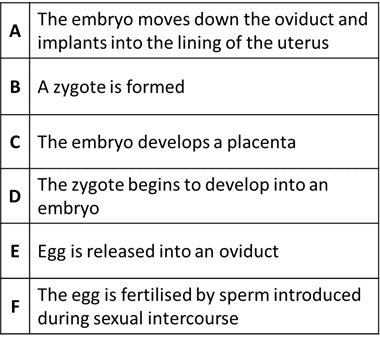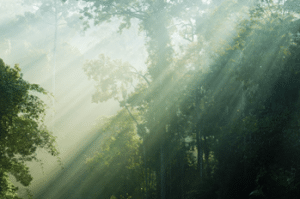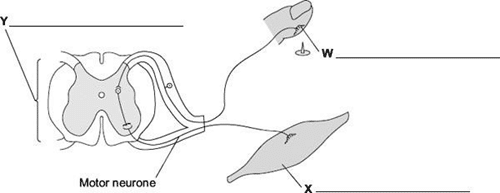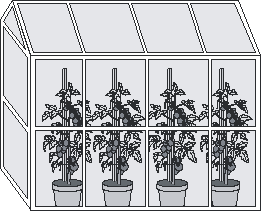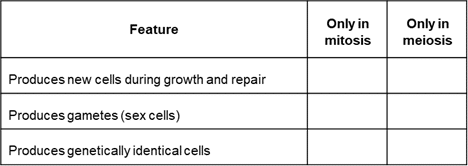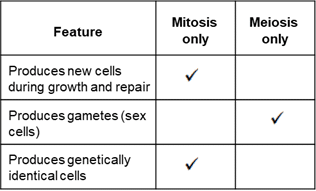A Star GCSE Biology Equivalency Revision
Question 1:
Yeast is a single-celled fungus.
The diagram below shows a yeast cell containing features labelled A to F.
1a)
Fill in the gaps below to name each feature of a yeast cell, corresponding to the labels above.
[3 marks]
SOLUTION:
A: Cell wall
B: Cell membrane
C: Vacuole
D: Cytoplasm
E: Nucleus
1b)
Put a tick (✓ ) in the box next to each statement that applies to the yeast cell.
[2 marks]
SOLUTION:
Its DNA is located inside the nucleus
Question 2:
The heart is part of the circulatory system.
The diagram below shows a section through the human heart.
2a)
Which arrow, A, B, C or D, shows blood leaving the heart in the pulmonary artery to go to the lungs?
[1 mark]
SOLUTION:
B
2b)
Which arrow, A, B, C or D, shows blood from the lungs entering the heart in the pulmonary vein?
[1 mark]
SOLUTION:
D
2c)
Valves in the circulatory system make sure blood only travels in one direction.
Name the type of blood vessel that has valves.
[1 mark]
SOLUTION:
Vein
Question 3:
3a)
The table below shows some events that occur during human reproduction.
Put these stages in order. The first stage corresponds to letter E.
[3 marks]
SOLUTION:
E F B D A C
3b)
During puberty, changes take place in the bodies of boys and girls called secondary sexual characteristics.
3b)i)
Which hormone controls the secondary sexual characteristics in boys?
[1 mark]
SOLUTION:
Testosterone
3b)ii)
Which hormone controls the secondary sexual characteristics in girls?
[1 mark]
SOLUTION:
oestrogen
Question 4:
The image below shows a tropical rainforest.
Population sizes are affected by both biotic and abiotic factors.
4a)
State two biotic factors in a tropical rainforest.
[2 marks]
SOLUTION:
Any 2 from:
- Food availability / competition
- Predators
- Disease
- Parasitism
- Presence of pollinating insects
- Availability of nesting locations
4b)
State two abiotic factors in a tropical rainforest.
[2 marks]
SOLUTION:
Any 2 from:
- Climate
- Light intensity
- Temperature
- Humidity
- Amount of rainfall / water availability
- Amount of sunlight / hours of daylight
- Soil conditions (any relevant points)
Question 5:
In this question you will be assessed on using good English, organising information clearly and using specialist terms where appropriate.
Diffusion is an important process in animals and plants.
The movement of many substances into and out of cells occurs by diffusion.
Describe why diffusion is important to animals and plants.
In your answer you should refer to:
- Animals
- Plants
- Examples of the diffusion of named substances.
[6 marks]
SOLUTION:
Examples of points made in the response:
Importance of diffusion:
- to take in substances for use in cell processes
- products from cell processes removed
Examples of processes and substances:
for gas exchange / respiration: \text{O}_2 in / \text{CO}_2 out
for gas exchange / photosynthesis: \text{CO}_2 in / \text{O}_2 out
food molecules absorbed: glucose, amino acids, etc
water absorption in the large intestine
water lost from leaves / transpiration
water absorption by roots
mineral ions absorbed by roots
extra information
Description of processes might include:
movement of particles / molecules / ions through a partially permeable membrane
(movement of substance) down a concentration gradient
osmosis: turgor / support / stomatal movements
0 marks
No relevant content.
(1 – 2 marks)
An example is given of a named substance
or
a process
or
there is an idea of why diffusion is important e.g. definition.
(3 – 4 marks)
At least one example of a substance is given
and
correctly linked to a process in either animals or plants.
(5 – 6 marks)
There is a description of a process occurring in either animals or plants that is correctly linked to a substance
and
a process occurring in the other type of organism that is correctly linked to a substance.
Question 6:
Protein synthesis is carried out by ribonucleic acid (RNA).
6a)
State two of the main differences between DNA and RNA.
[2 marks]
SOLUTION:
Any 2 from:
- DNA is double helix, RNA is single strand
- DNA contains sugar deoxyribose, RNA contains ribose
- RNA contains the base uracil (U) instead of thymine (T)
6b)
State the two types of RNA that take part in protein synthesis.
For each type, give their use during this process.
[4 marks]
SOLUTION:
Messenger RNA (mRNA) – forms a copy of the DNA code
Transfer RNA (tRNA) – carries amino acids to the ribosomes to make protein
6c)
State, in order, the names of the two stages of protein synthesis.
[2 marks]
SOLUTION:
Transcription then translation
Question 7:
The diagram shows the structures involved in a reflex action.
7a)
Name the structures labelled W, X and Y.
[3 marks]
SOLUTION:
W – receptor / nerve ending
X – effector / muscle
Y – spinal cord / central nervous system / CNS
7b)
The control of blood sugar level is an example of an action controlled by hormones.
Give two ways in which a reflex action is different from an action controlled by hormones.
[2 marks]
SOLUTION:
Any 2 from:
- reflex action quicker
- effect of reflex action over shorter period
- hormone involves blood system and reflex involves neurones / nerve cells
ignore nervous system / nerves
- reflex involves impulses and hormone involves chemicals
- reflex action affects only one part of the body
ignore involves brain
ignore outside / inside stimuli
Question 8:
In the UK, most tomatoes are grown in glasshouses or polytunnels.
8a)
The walls and roofs of glasshouses and polytunnels are made of transparent materials.
Suggest why.
[1 mark]
SOLUTION:
To allow natural light to enter
8b)
Briefly explain how the greenhouse effect raises the temperature inside glasshouses.
[3 marks]
SOLUTION:
Infrared radiation from the Sun is absorbed by soil and re-radiated at longer wavelength. The longer wavelength radiation cannot escape (so greenhouse heats up)
8c)
Some glasshouses are fitted with heaters that burn fossil fuels.
Explain how the by-products of burning fossil fuels can be used to increase the crop yield inside the glasshouse
[3 marks]
SOLUTION:
By-products are carbon dioxide and water.
Carbon dioxide is a raw material for photosynthesis.
Water vapour maintains a moist atmosphere and helps to reduce water loss from plants.
Question 9:
Mitosis and meiosis are types of cell division.
9a)i)
For each feature in the table, tick one box to show if the feature occurs:
- only in mitosis
- only in meiosis.
[3 marks]
SOLUTION:
9a)ii)
Name the organ that produces gametes (sex cells) in:
- A man
- A woman
[2 marks]
SOLUTION:
Man: Testes / testis
Woman: ovaries / ovary
9b)
X and Y chromosomes are the sex chromosomes. They determine a person’s sex.
What sex chromosomes will be found in the body cells of:
- A man
- A woman
[2 marks]
SOLUTION:
Man: XY
Woman: XX
9c)
A man and a woman decide to have a child.
What is the chance that the child will be a boy?
[1 mark]
SOLUTION:
0.5 or 50 \%
Question 10:
Explain how a vaccination makes a person immune to a disease.
[4 marks]
SOLUTION:
Dead or inactive or weak form of pathogen / bacterium / virus / microorganism introduced which stimulates white cells / lymphocytes / leucocytes to produce antibodies. The antibodies are made quickly on re-infection.



